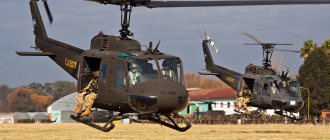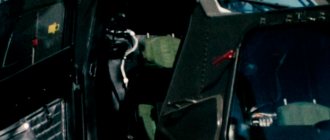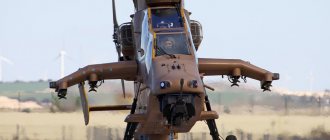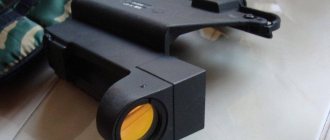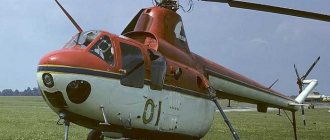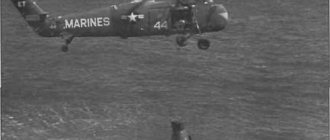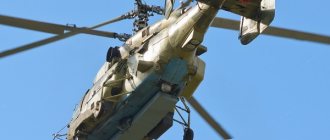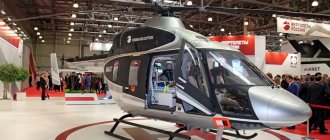In March 1965, it began developing a combat helicopter for close air support of troops based on the Model 204 helicopter (UH-1B/-1C Iroquois). It was intended to provide the US Army with a test helicopter that would combine the new narrow fuselage with a small cross-section and tandem seating, power plant, main rotor and transmission of the UH-1C helicopter. The prototype flew on September 7, 1965. The helicopter, designated Model 209, was tested beginning in December of that year, and orders for two pre-production aircraft and 110 production aircraft followed in April 1966.
Bell AN-1 Cobra – video
Eventually designated AH-1G and named "Hugh Cobra", the helicopter began being delivered to the US Army in June 1967, and in September it began to be used in combat operations in Vietnam. 1,127 AH-1G helicopters were delivered to the US Army, including dual-control TH-1G trainers.
The production helicopter AH-1G, which became the base for further modifications, had a single-rotor design, with a tail rotor, one gas turbine engine and a ski landing gear. The fuselage is all-metal, semi-monocoque type. The crew cabin is two-seater, with gunner and pilot seats located one behind the other. The floor level in the gunner's compartment (located in front of the pilot) is 0.25 m lower. The canopy with flat glass minimizes glare and increases the space above the pilot's head; the helicopter uses an improved autonomously operating emergency release system for windows and doors. To protect the crew and the most critical sections of the structure and components from ground fire, lightweight steel armor was used. The tail boom structure is reinforced to withstand 23mm shells. The helicopter airframe is painted to reduce visual and IR visibility.
The wing has a span of 3.28 m, mid-mounted, straight, trapezoidal in plan, which unloads the main rotor in horizontal flight and carries suspension units for weapons, containers with equipment or fuel tanks. The chassis is non-retractable, ski-mounted, made of aluminum alloys, with plastic fairings of the struts. To improve wear resistance, steel linings are attached to the skis below. The power plant consists of one turboshaft gas turbine engine, located in a fairing on top of the fuselage and equipped with side air intakes, an exhaust nozzle deflected upward, on which a casing is installed to cool the exhaust gases with outside air and reduce IR radiation. The fuel is contained in protected tanks with a capacity of 980 liters, closed in a fuel replenishment system for the supply tank. Electronic equipment includes: communication means (between crew members. HF communication station, meter range communication station), navigation system, radar detection receiver, active IR jammer transmitter. situation indicators in the horizontal and vertical planes, a radio altimeter, a backup magnetic compass for the second pilot, an identification system transponder.
The armament consists of containers with NUR with folding tail, which are suspended under the wing on external pylons. and a universal M-28 turret mounting either two machine guns or two 40-mm rocket-propelled grenade launchers. The combat load weight is 450 kg. The US Marine Corps purchased 38 AH-1Gs in 1969 in anticipation of the delivery of 49 AH-1J Sea Cobras ordered in May 1968. Examples, mostly similar to the Army AH-1G helicopter, were supplied to the Spanish Navy (8 vehicles designated Z.14) and to Israel (6 vehicles).
Modifications
TH-1G "Hugh Cobra" is the designation for the AH-1G dual-control trainer helicopter.
The AH-1J Sea Cobra was the initial version for the US Marine Corps. equipped with a power plant with two T400-SR-400 turboshaft engines with a total shaft power of 820 kW/1100 hp. in nominal mode, but with takeoff or combat shaft power of 932 kW/1250 hp; Since 1970, 271 vehicles have been produced, 63 of which have been used by Marines in Vietnam since February 1971.
AH-1Q "Hugh Cobra" - 93 AH-1G vehicles, converted in 1973-1974. for launching Tou anti-tank missiles.
AH-1R "Hugh Cobra" - a variant similar to the AH-1G, but with a more powerful T53-L-703 turboshaft engine.
AH-1S "Hugh Cobra" - the general designation under which existing AH-1 vehicles were upgraded to be capable of anti-tank warfare using Tow missiles, as well as the designation of newly built vehicles. It also includes the "Upgraded" AH-1S, which consists of 197 AH-1Gs and 93 AH-10s with improved gearbox and transmission, improved rotor, T53-L-703 engine and Tou missiles; 100 similar helicopters, designated “Serial” AH-1S, were production vehicles with advanced electronics, systems and equipment; 98 “Rifle” AH-1S vehicles, similar to the “Serial” AH-1S helicopters, but with an improved turret and fire control system; and 126 new production vehicles.
AH-1F - “Upgraded” AH-1S, incorporating all the best qualities of the AH-1S helicopters, plus advanced navigation and combat electronic equipment and protection systems, including sighting equipment with a laser rangefinder, a computer, a helmet-mounted sight, an IR radiation reduction system motor and IR trap.
The AH-1T "Improved Sea Cobra" is a generally improved version of the AH-1J helicopter, including a higher-power T400 WV 402 powerplant, a Model 214 helicopter dynamic system and a fuselage lengthened by 1.09 m. 57 vehicles equipped for anti-tank warfare were built. using Tou missiles (beginning of deliveries - October 1977).
AN-1W “Super Cobra” is a variant based on the AN-1T “Sea Cobra” helicopter. It is the most advanced machine from the AN-1 series of twin-engine helicopters, which also included the AH-1J helicopters and the above-mentioned AN-1T. The first flight took place on November 16, 1983. The first production helicopter AN-1W was delivered in March 1986 to the US Marine Corps. To extend the service life, it is possible to modernize the helicopter into the following modifications: AN-1 W IWS - a modification of the helicopter with a new flight deck, an improved computer, a digital map and color multi-purpose displays to reduce the pilot’s workload; AH-1BW - modification of the AN-1W with a four-bladed main rotor, two blades can be folded, and a new hub from the Bell 412 helicopter. First flight was made on January 24, 1989. Take-off weight increased to 7620 kg, maximum speed - up to 370 km/h , maximum speed - up to 315 km/h, maximum cruising speed - up to 297 km/h.
AH-1W "Venom" - development of the AH-1 BW helicopter in accordance with the requirements for a combat helicopter for the British Armed Forces. Equipped with weapons for operation in low visibility conditions, at night and for autonomous navigation. A single-rotor helicopter with a tail rotor, an all-metal semi-monocoque fuselage, a mid-wing (each with four weapons suspension units), two gas turbine engines and a ski landing gear. The crew cabin, as on previous AN-1 series helicopters, is two-seater (the gunner sits in the front, the pilot sits in the back). The seats, side panels and the most critical structural elements are armored. Electronic weapons control equipment is located in a compartment under the nose. The horizontal tailplane is located on the tail boom in front of the vertical swept tailplane, on which the two-bladed tail rotor is located. It is possible to install wheels for taxiing on the ground. The power plant consists of two gas turbine engines with a power of 1625 hp each, placed on top of the fuselage in a horizontal position and having side air intakes. The nozzles have ejector devices that reduce the temperature of the exhaust air, which reduces the IR signature of the helicopter. The fuel system consists of two tanks (total capacity about 1150 l) located in the fuselage. It is possible to mount two additional fuel tanks of different capacities.
Electronic equipment includes communications, navigation equipment (without radar) and identification systems. The helicopter is equipped with an electric universal turret system with a three-barrel M-197 cannon (caliber 20 mm, rate of fire 675 rounds/min). The turret is controlled by the first or second pilot using a helmet-mounted sight or an aiming device in a missile weapons package. In the anti-tank version, the helicopter can be armed with eight Tou or Hellfire ATGMs, in the air combat version - AIM-9L Sidewinder or Stinger missiles. There is also provision for suspension of two containers with 20 mm caliber guns, FFAR 70 mm caliber NUR or Zuni 127 mm caliber NUR. The helicopter's armament kit is complemented by ALE-39 dipole reflector dispersal machines and SU-44 tracers. as well as smoke bombs.
During combat operations in the Persian Gulf, the US Marine Corps used up to 50 AN 1W helicopters. The flight time of individual vehicles reached 16 hours per day with a mission readiness rate of 92%. Deliveries of production helicopters ceased in 1986, but they remain part of the fleet of combat helicopters of the United States (and other countries of the world) and, presumably. will be withdrawn from it only at the beginning of the 21st century. To extend their service life, the helicopters are constantly modified, in particular, the installation of Stinger air-to-air missiles for air combat and equipment for flying at night, as well as improving crew safety and operational reliability, is provided.
Historical reference
In the 60-70s of the last century, the US Army successfully used UH-1 helicopters as a transport helicopter, for transporting personnel, and for evacuation. Although the Iroquois was armed with NAR units and machine guns, it still required a specialized, much more protected and armed, high-speed and maneuverable attack helicopter. In March 1965, development began in the United States to create a multifunctional helicopter that could fully perform many of the combat missions assigned to it.
The AH-1 Huey Cobra, created on the basis of components and assemblies of the same proven UH-1, won the competition. The first flight of the AN-1G Cobra took place in September 1965. Six months passed from the start of development to the rollout of the first prototype helicopter, as stipulated in the contract with the US Army. In September, chief pilot Bill Quinlan first flew a helicopter, designated UH-1H - another modification of the Hugh. But soon the US Army command identified a new class of helicopters - attack, and the UH-1H, according to this classification, became known as the AH-1G
(Attac Helicopter - 1 Gunship), and unofficially - "Hugh Cobra". Externally, the AH-1G is radically different from its progenitor, the UH-1B. However, the propulsion system, transmission and tail boom have been preserved. The main rotor (RO) underwent minimal changes: higher speed profiles were used at the end parts of the blades and the stabilizing rods characteristic of early models of Bell helicopters were removed. The very design of the semi-rigid two-bladed propeller, which has a hub with common horizontal and axial hinges of the “door hinge” type, has not changed. But the front part of the fuselage was designed anew. The gunner and pilot were placed one behind the other in a narrow cockpit with excellent visibility. As a result, the width of the fuselage was increased to 90 cm. The reduction in drag made it possible, with the same engine as the Hugh, to increase the maximum speed, although the weight of the empty helicopter increased.
According to the designers, both the pilot and the gunner could control the helicopter. This decision gave rise to certain problems, since the main place in the front cockpit was occupied by the sight and weapon controls. I had to replace the central cyclic step lever with a short side handle located on the right. The battle formation of the Cobras, like fighter aircraft, was built on the basis of a pair: leader - wingman. The pair ensured good communication and did not constrain the maneuver. In Vietnam, helicopters spent most of their flight time over terrain not controlled by the US Army or its South Vietnamese allies. The use of helicopters in pairs increased the crew’s chances of surviving a forced landing on foreign territory. The second helicopter in this case provided covering fire for the downed comrade until the search and rescue helicopter arrived.
In the early stages of the war, the mission of attack helicopters was to destroy infantry and light vehicles carrying people and cargo (such as sampans and bicycles). The firepower of the Cobras was quite sufficient to defeat such targets. The situation changed when a stream of Soviet-made heavy equipment poured along the Ho Chi Minh Trail into South Vietnam. The insufficient effectiveness of the NAR to destroy the PT-76, T-34 and T-54 tanks was immediately revealed. Hugh Cobras came into close contact with tanks in Laos in 1971. The 2nd squadron of the 17th air cavalry regiment destroyed five tanks, four PT-76s and one T-34 with unmanned aerial vehicles equipped with heavy warheads. Attempts to destroy the tanks with fire from the 20-mm cannons of the suspended containers were unsuccessful. Tanks were difficult to hit not only with missiles. Excellent camouflage and camouflage coloring made them very difficult to detect. Thus, in one of the combat missions, two columns of tanks were discovered. As a result of the ensuing strike, the convoy was stopped, but not a single tank caught fire. The fact is that the NARs exploded inside the armored hull, destroying the crew. But if the fuel did not ignite or the ammunition did not detonate, it was not possible to establish from the air that the tank was disabled. In 1972, the Americans gave a surprise by using helicopter ATGMs against tanks, but the Vietnamese also surprised the Yankees. In the same year, they used Soviet Strela MANPADS to combat low-flying targets. When designing the Hugh Cobra, the designers included measures to counteract heat-seeking missiles by using exhaust gas cooling, but this was not enough.
The Arrows confidently captured the helicopters, and the first to be shot down was a Hugh, then two Cobras. In the first case, the AN-1G was flying alone at an altitude of about 1000 m. After being hit by Strela, the car fell apart in the air. In another case, a rocket hit the tail boom. The Americans assessed the threat. All helicopters flying in Vietnam were equipped with an elbow pipe that diverted hot gases upward into the plane of rotation of the main rotor, where a powerful turbulent flow instantly mixed them with the surrounding air. As practice has shown, the sensitivity of the Strela homing head was not enough to capture helicopters modified in this way. During the years of the war in Southeast Asia, Cobras demonstrated excellent survivability. Of the 88 Cobras that took part in the operation in Laos, 13 were shot down. By the end of the Vietnam War, the US Army had 729 AN-1G helicopters out of 1,133 built. The lion's share of the missing 404 vehicles remained in Vietnam forever.
Performance characteristics of Bell AN-1 Cobra
– First flight: September 7, 1965 – Adopted into service: 1967
Bell AN-1 Cobra crew
– 2 people
Overall dimensions of Bell AN-1 Cobra
– Main rotor diameter: 13.41 m – Tail rotor diameter: 2.59 m – Length with rotation. propellers: 16.18 m – Fuselage length: 13.59 m – Fuselage width: 0.99 m – Height: 4.09 m – Wingspan: 3.28 m
Ves Bell AN-1 Cobra
– Maximum take-off weight: 4535 kg – Empty helicopter weight: 2993 kg
Bell AN-1 Cobra engine
– Powerplant: 1 x Avro Lycoming T53-L-703 – Power: 1x1690 hp
Speed Bell AN-1 Cobra
– Maximum speed: 315 km/h – Cruising speed: 227 km/h – Maximum rate of climb: 8.22 m/s
Flight range of Bell AN-1 Cobra
– 510 km
Static ceiling Bell AN-1 Cobra
– 3720 m
Armament Bell AN-1 Cobra
– one 20 mm three-barreled M197 Vulcan cannon with 750 rounds of ammunition
Combat load – 1542 kg on 4 hardpoints: – 8(2x4) BGM-71 TOW ATGMs and – 2 LAU-68 or LAU-6 launchers with 7x70 mm or 19x70 mm NUR
Possible installation of – 4 AIM-92 Stinger air-to-air missiles, – 2x8 AGM-114 Hellfire air-to-surface missiles, – containers with cannon and machine gun weapons, – 2 40 mm grenade launchers
